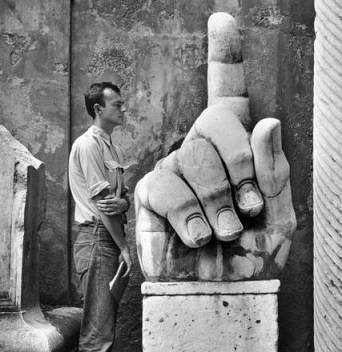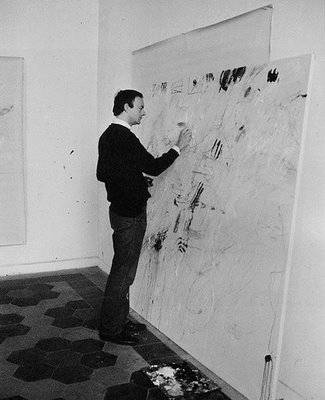
- Twombly sought to contradict audiences' conventional understandings of art, blurring long-held distinctions between drawing and painting, as well as depicting refined Classical themes with unidentifiable doodles and splotches. Similarly, he often made works deliberately opaque to challenge viewers to find their own meanings; in some cases Twombly intended his works to echo a specific inspiration or story, while in other instances he simply selected random titles after their completion.
- Although influenced by the gestural brushstrokes and compositions of action painters, as well as by Dadaism and Surrealism, Twombly drastically reimagined aspects of those techniques and concepts to create an immediately recognizable, individual style.
- Writing and language served as major conceptual foundations for Twombly's art; the written word, in the form of poems, myths and histories, inspired much of his work. He focused on the process of writing, both by sketching words directly onto the canvas and by creating line- and handwriting-based compositions.
Edwin Parker Twombly, Jr. was born in Lexington, Virginia in 1928. Like his father, who briefly pitched for the Chicago White Sox, he was known as Cy, after Cy Young. His father later became a coach and athletic director at Washington and Lee University. Twombly's parents were from the Northeast, so he made frequent trips to Massachusetts and Maine, but the South, with its sense of history and autonomy, ultimately became an integral aspect of his identity. As a young boy, Twombly's parents encouraged his interest in art, and at 12 years old he started studying with Spanish modern painter Pierre Daura.
Following high school, Twombly began formal art training at the School of the Museum of Fine Arts in Boston (1947-1949), where he became interested in the Dadaist and Surrealist work of artists such as Kurt Schwitters and Alberto Giacometti. At his parents' suggestion, Twombly then spent a year at Washington and Lee's newly created art program before moving to New York in 1950 to study at the Art Students League. Exposure to numerous New York gallery exhibitions of artists such as Kline, Pollock and Motherwell began to shape Twombly's own aesthetic away from the figurative toward abstraction. While at the League, he metRobert Rauschenberg, who became a close friend and artistic influence. At Rauschenberg's encouragement, Twombly studied at Black Mountain College in North Carolina (1951-1952). In 1952, Twombly traveled to Italy and North Africa with Rauschenberg on a grant from the Virginia Museum of Fine Art. Upon returning, the two artists had a joint 1953 exhibition at Stable Gallery in New York, which resulted in such a hostile and negative response from the public that gallery director Eleanor Ward had to remove the visitor comments book.
Twombly's work at this time was largely in black and white, influenced both by Rauschenberg's paintings and the monochromatic work of De Kooning, Kline and Motherwell. Twombly drew on ideas of the primitive, notions of ritual and the psychoanalytic concept of the fetish, and also took inspiration from his European travels in these early works. From 1953 to 1954, Twombly was drafted into the army, where he served as a cryptographer at Camp Gordon near Augusta, Georgia and at the Pentagon in Washington, D.C. On weekend leaves, Twombly spent time in his hotel room in Augusta making scrawled, biomorphic drawings, which he has said set "the direction everything would take from then on." While in the army, he also modified the Surrealist technique of automatic drawing by creating compositions in the dark after lights out. These "blind" drawings resulted in elongated, distorted forms and curves that became distinct stylistic motifs in his later work.
scrawled, biomorphic drawings, which he has said set "the direction everything would take from then on." While in the army, he also modified the Surrealist technique of automatic drawing by creating compositions in the dark after lights out. These "blind" drawings resulted in elongated, distorted forms and curves that became distinct stylistic motifs in his later work.
Twombly's work at this time was largely in black and white, influenced both by Rauschenberg's paintings and the monochromatic work of De Kooning, Kline and Motherwell. Twombly drew on ideas of the primitive, notions of ritual and the psychoanalytic concept of the fetish, and also took inspiration from his European travels in these early works. From 1953 to 1954, Twombly was drafted into the army, where he served as a cryptographer at Camp Gordon near Augusta, Georgia and at the Pentagon in Washington, D.C. On weekend leaves, Twombly spent time in his hotel room in Augusta making
 scrawled, biomorphic drawings, which he has said set "the direction everything would take from then on." While in the army, he also modified the Surrealist technique of automatic drawing by creating compositions in the dark after lights out. These "blind" drawings resulted in elongated, distorted forms and curves that became distinct stylistic motifs in his later work.
scrawled, biomorphic drawings, which he has said set "the direction everything would take from then on." While in the army, he also modified the Surrealist technique of automatic drawing by creating compositions in the dark after lights out. These "blind" drawings resulted in elongated, distorted forms and curves that became distinct stylistic motifs in his later work.
Twombly worked less frequently in the late 1970s and 1980s, but continued creating important canvases. In the mid-1970s, he also returned to sculpture, a medium in which he had not worked for almost 20 years. These sculptures, often focusing on Classical themes, were largely assembled from found objects and painted white. His time in Italy continued to influence Twombly's work; he spent much time in the medieval port city of Gaeta, and many of his paintings from the 1980s reflected his interest in the sea. Critical reception of his work became more positive in the 1980s, as well, partially due to a new interest in modern European art. Classical references persisted in his later work, particularly in the form of Bacchus, the god of wine. Twombly's paintings in the next decades expanded his previous use of color, applied with gestural brushstrokes that occasionally depicted more recognizable forms, such as flowers and landscapes. Currently living in Italy and Virginia, Twombly is represented by Gagosian Gallery in New York.

Комментариев нет:
Отправить комментарий